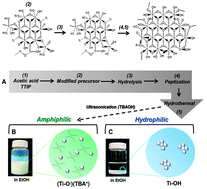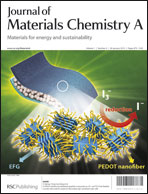Superior photoelectrodes for solid-state dye-sensitized solar cells using amphiphilic TiO2†
Abstract
Anatase amphiphilic TiO2 (am-TiO2) nanoparticles with an average diameter of ∼15 nm were synthesized using a sol–gel hydrothermal synthesis. The colloidal dispersion of am-TiO2 in alcoholic solvents had outstanding stability for several months at room temperature (RT). Hierarchically structured TiO2 nanospheres (TiO2-NSs) were then successfully prepared by an electrostatic spray (e-spray) method using the am-TiO2 dispersion at RT. The e-sprayed TiO2-NSs were employed as photoelectrodes for solid-state dye-sensitized solar cells (ss-DSSCs), in which a novel plastic crystal/polymer blend based solid-state electrolyte (PC-SSE), iodine-doped succinonitrile/polyacrylonitrile, was used. A photovoltaic power conversion efficiency (PCE) of ∼7.6% was reached under simulated AM 1.5 G (100 mW cm−2) illumination, while the incident photon-to-electrical current conversion was >60% upon excitation at 550 nm. The unique morphology of the TiO2-NSs, in which primary anatase TiO2 nanoparticles are interconnected within the submicron-scale spheres, exhibited superior characteristics as photoelectrodes for our ss-DSSCs compared to conventional TiO2 nanoparticles (TiO2-NPs). The nanoparticles-in-sphere shape offered enhanced surface area and pore volume for high dye-loading and beneficial solid-state electrolyte (SSE) infiltration, while the submicron-scale of the spheres induced efficient visible-light scattering. The efficient interconnection among the primary anatase TiO2 nanoparticles within the e-sprayed NSs offered enhanced charge collection efficiency and photoelectron density, which were confirmed by intensity-modulated photocurrent/photovoltage spectroscopy and electrochemical impedance spectroscopy. These superior properties of the TiO2-NSs were manifested in the cell performance. The PCE of the TiO2-NS-based ss-DSSCs was >2 times higher than that of TiO2-NP-based ss-DSSCs, with notable concurrent improvement in the short-circuit current (JSC = 13.9 mA cm−2), open circuit voltage (VOC = 765 mV), and fill factor (FF = 71.6%). The optimized cell efficiency of 7.6% is thus far the highest reported efficiency for PC-SSE-based DSSCs. Both the single-crystal-like anatase primary particles and the advantageous morphology effectively contributed to the high performance of the ss-DSSCs. Since the e-spray method is a high-throughput, scalable process, our hierarchically structured TiO2-NSs are a promising material for high-efficiency ss-DSSCs, possessing a range of advantages over conventional TiO2-NPs.


 Please wait while we load your content...
Please wait while we load your content...